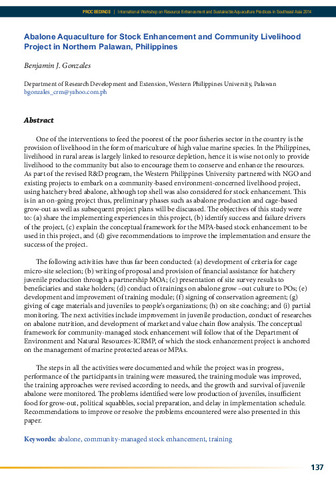| dc.contributor.author | Salayo, Nerissa D. | |
| dc.contributor.author | Altamirano, Jon | |
| dc.contributor.author | Montinola, Quenie S. | |
| dc.contributor.author | Castel, Raisa Joy G. | |
| dc.contributor.author | Barrido, Rafael T. | |
| dc.contributor.author | Tormon-West, Dianne Hope | |
| dc.contributor.author | Baylon, Roselyn | |
| dc.contributor.author | Pacardo, Nelbert G. | |
| dc.contributor.author | Arnaiz, Margarita T. | |
| dc.contributor.editor | Aya, Frolan A. | |
| dc.contributor.editor | de la Peña, Leobert D. | |
| dc.contributor.editor | Salayo, Nerissa D. | |
| dc.contributor.editor | Tendencia, Eleonor A. | |
| dc.date.accessioned | 2021-12-16T02:14:03Z | |
| dc.date.available | 2021-12-16T02:14:03Z | |
| dc.date.issued | 2021-12 | |
| dc.identifier.citation | Salayo, N. D., Altamirano, J. P., Montinola, Q. S., Castel, R. J. G., Barrido, R. T., Tormon-West, D. H. M., Baylon, R. N., Pacardo, N. G., & Arnaiz, M. T. (2021). Integrated production of abalone, Haliotis asinina, and sandfish, Holothuria scabra, through Community-Based Resource Enhancement (CBRE) in Molocaboc Island in Sagay Marine Reserve, Philippines. In F. A. Aya, L. D. de la Peña, N. D. Salayo, & E. A. Tendencia (Eds.), Proceedings of the International Workshop on the Promotion of Sustainable Aquaculture, Aquatic Animal Health, and Resource Enhancement in Southeast Asia (pp. 107–120). Tigbauan, Iloilo, Philippines: Aquaculture Department, Southeast Asian Fisheries Development Center. | en |
| dc.identifier.isbn | 9789719931102 (Print) | |
| dc.identifier.isbn | 9789719931119 (PDF) | |
| dc.identifier.uri | http://hdl.handle.net/10862/6261 | |
| dc.description.abstract | This study conducted participatory enhancement of abalone Haliotis asinina and sandfish Holothuria scabra stocks using hatchery-bred and reared seeds released in the shores of Molocaboc Island in multi-use buffer zone of Sagay Marine Reserve, Philippines. The Community-Based Resource Enhancement (CBRE) process, implemented continuously from 2006 to 2019, include social and biophysical preparation, formulation of fisheries management and governance strategies, release of hatchery-reared juveniles, monitoring and periodic assessment, and socioeconomic impact assessment.
CBRE was implemented through a tri-party collaboration involving fisherfolks, local government and research institutions. The abalone and sandfish enhancement procedures comprised of breeding in hatcheries, rearing of juveniles either in nursery facilities or net cages in coastal areas, and release in enhancement areas.
A total of 11,500 tagged abalone juveniles were released in 11 batches in a protected coralline site from 2011 to 2015. Monthly monitoring showed increase in abalone catch per unit effort (3 divers, 1 hour fishing) in the release site from 0–2 individuals during baseline in 2011 to up to 150 individuals until 2019, including spill-overs without tags. Meanwhile, 96,400 hatchery-bred and reared sandfish juveniles were stocked in floating netcages in 15 batches and later released in sea ranch where mean density increased significantly from 3 to 138 individuals/ha in 2015 to 2019. Gleaning should comply with locally instituted catch-size regulation to sustain the fishery.
Additional project activities include the construction and operationalization of a smallscale solar-powered hatchery on-site; freeze-drying trials of abalone meat to improve market reach; and initiatives to replicate the project in Lahuy Islands in Caramoan, Camarines Sur. Aquaculture, through seed production, therefore plays a key role in enhancement of threatened high-value species. Resource enhancement benefitted the fisheries through participatory management and eventually provided spill-overs to supplement income of marginalized fishers. | en |
| dc.description.sponsorship | The authors thank SEAFDEC/AQD and collaborators such as the Barangay Molocaboc FARMC/MOSRA and PAMBSMR of Sagay City. Funds and program support were provided by the GOJTF (8100-T-RD-SE0105, SE0110, and SE0015). The authors acknowledge the inputs from GOJTF Co-Managers Dr. Koichi Okuzawa, Dr. Hiroshi Ogata, Dr. Teruo Azuma, Dr. Takuro Shibuno, Dr. Chihaya Nakayasu, and Dr. Koh-ichiro Mori. | en |
| dc.language.iso | en | en |
| dc.publisher | Aquaculture Department, Southeast Asian Fisheries Development Center | en |
| dc.rights | Attribution-NonCommercial-ShareAlike 3.0 IGO | * |
| dc.rights.uri | http://creativecommons.org/licenses/by-nc-sa/3.0/igo/ | * |
| dc.subject | stock enhancement | en |
| dc.subject | abalones | en |
| dc.subject | sandfish | en |
| dc.subject | community-based resource enhancement | en |
| dc.subject | Philippines | en |
| dc.subject | Haliotis asinina | en |
| dc.subject | Holothuria scabra | en |
| dc.title | Integrated production of abalone, Haliotis asinina, and sandfish, Holothuria scabra, through Community-Based Resource Enhancement (CBRE) in Molocaboc Island in Sagay Marine Reserve, Philippines | en |
| dc.type | Conference paper | en |
| dc.citation.spage | 107 | |
| dc.citation.epage | 120 | |
| dc.subject.asfa | abalone culture | en |
| dc.subject.asfa | aquaculture | en |
| dc.subject.asfa | socioeconomic aspects | en |
| dc.subject.asfa | site selection | en |
| dc.subject.asfa | fishers | en |
| dc.citation.conferenceTitle | Proceedings of the International Workshop on the Promotion of Sustainable Aquaculture, Aquatic Animal Health, and Resource Enhancement in Southeast Asia | en |




